
Total Pictorial Devotion: Interview with Lorna Mills
by Ben Dreith

Lorna Mills appears on the screen, and even though I’ve had my frustrations with digital interviews, I can’t imagine it any other way. Behind her bespectacled figure, the screen is a cascade of bytes and images: clusters of grapes, clouds spilling from an empty background as if from a spigot, and mascots from a high school in some alternate dimension. I mention it to her and she changes it again, to a sea of naked bodies humping. We laugh and it’s as if in that moment, she, or maybe both of us, are inhabiting the world of digital salvage and reanimation that she has been building for decades.
The Canadian artist has been a name in net.art since the early 1990s. Trained in classical arts, Mills taught herself the ins and outs of programming and film and even worked for a time as a digital game programmer. Her work features images pulled from all parts of the Internet, and her digital collages feature GIFS pulled from all over the Internet. She has shown work at the Art Gallery of Ontario, Hayward Gallery in London, and Verse in London. She has also been a curator for the digital exhibition Wrong Biennial and was selected as one of the artists presented on the large screens in Times Square as part of the Midnight Moment Project.
Ben Dreith: Even though your work is so obviously digital, many of these images are tied to physical sensations, such as the cannoli, the orgies, the penises – why do you gravitate towards these?
Lorna Mills: Yes and no, as far as the cannolis and orgies go. I do collect from porn fail sites, but it’s such a small percentage of what I work with. But that’s the stuff everyone focuses on, which I don’t mind at all. Slipping something contentious or ridiculous or graphic into a large collage gives it a spark. Most of the collages aren’t about porn, but it helps and it’s funny. It’s ridiculous sex, not erotica. I loathe erotica. It’s like coffee table porn. I gravitate more toward the most idiotic images, when it’s mocking itself.
BD: It’s also very human and people just like sex, too. It makes me think of how desensitized to all these hardcore things we see on the Internet all the time. But then I look at your work, and the juxtaposition makes the images more shocking.
LM: Absolutely, yes, the fact that they were chosen and composed into a larger composition. That alone makes them stand out.
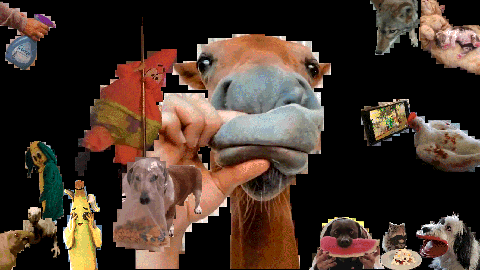


Petting Zoo: Noble orphans by Lorna Mills
BD: The history of collage seems to coincide with advertisements and these commercial images. Are you thinking about a critique of the digital image when you’re putting these together?
LM: That critique sometimes becomes apparent when I mix the images. For the most part I’m just trying to make something I’ve never seen before and something my audience has never seen before.
BD: When you started making these images, digital art was still a bit obscure. Now it’s dominant and people look at their phones all the time. How has this shift changed the way people approach your art?
LM: I can answer that in a broader sense, especially with the rise of the NFT and the ridiculous value assigned to them. It was that sudden monetary value that gave digital art more of a cultural hold. I’ve been doing this for so long and have been embedded in the scene for so long—so I was so excited about it. For many years it’s been the only thing I was interested in when it came to contemporary art. Either straight digital art or work that references the digital or the Internet. As far as NFTs go I am in it hook, line and sinker. I'm making a respectable living from it. I don't sell for the high prices that a lot of men who are my contemporaries do and there's a reason for that as we all know
BD: Has the prevalence of AI changed your approach?
LM: Some audiences are outraged by AI and I think that’s reactionary. It’s an artist's tool. On the other side of it, AI is doing something for us that has nothing to do with being artists. It's answering the phone for us, and becoming a surrogate to actual human connection in ways that should be parsed and discussed. I don't use it. I'm doing what I want to do. People just get ridiculous over so much now in terms of any new media.
BD: It seems that many people have trouble with digital art being viewed in a live setting, and have a more traditional view of what an exhibition should be.
LM: Some people are uncomfortable with what they think is immaterial, but it's not, it's presented on a screen or some kind or projection. It's not as ephemeral as it's described. I have been told by friends that many in the general public think all artists are having it on with them. As if we're all making fun of them and it's all a big con. For the most part, it’s not, but if people don't care about art, they don't care about art. I can't force that.
LM: That critique sometimes becomes apparent when I mix the images. For the most part I’m just trying to make something I’ve never seen before and something my audience has never seen before.
BD: When you started making these images, digital art was still a bit obscure. Now it’s dominant and people look at their phones all the time. How has this shift changed the way people approach your art?
LM: I can answer that in a broader sense, especially with the rise of the NFT and the ridiculous value assigned to them. It was that sudden monetary value that gave digital art more of a cultural hold. I’ve been doing this for so long and have been embedded in the scene for so long—so I was so excited about it. For many years it’s been the only thing I was interested in when it came to contemporary art. Either straight digital art or work that references the digital or the Internet. As far as NFTs go I am in it hook, line and sinker. I'm making a respectable living from it. I don't sell for the high prices that a lot of men who are my contemporaries do and there's a reason for that as we all know
BD: Has the prevalence of AI changed your approach?
LM: Some audiences are outraged by AI and I think that’s reactionary. It’s an artist's tool. On the other side of it, AI is doing something for us that has nothing to do with being artists. It's answering the phone for us, and becoming a surrogate to actual human connection in ways that should be parsed and discussed. I don't use it. I'm doing what I want to do. People just get ridiculous over so much now in terms of any new media.
BD: It seems that many people have trouble with digital art being viewed in a live setting, and have a more traditional view of what an exhibition should be.
LM: Some people are uncomfortable with what they think is immaterial, but it's not, it's presented on a screen or some kind or projection. It's not as ephemeral as it's described. I have been told by friends that many in the general public think all artists are having it on with them. As if we're all making fun of them and it's all a big con. For the most part, it’s not, but if people don't care about art, they don't care about art. I can't force that.
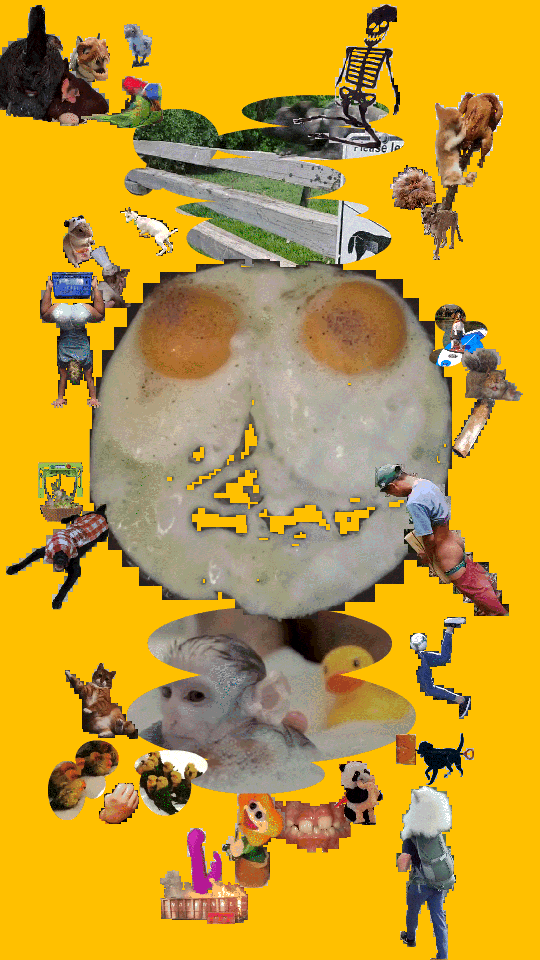
Pandora's Shiny Girl 2023, gif collage on video, by Lorna Mills
BD: Do you think about this contrivance in art when focusing on the ridiculous or mundane in your work?
LM: Well, nothing’s mundane. Once you make it into art, it gets elevated to something else. I come from a traditional background; I was trained as a painter. So I’ve got an aesthetic grounding and knowledge of history with some major gaps, but more knowledge than the average viewer. I'm totally devoted to the pictorial as opposed to the sculptural and, or conceptual. Artists want to be part of a continuum, with the history of art. We want to be remembered, and when we're creating work, we want to feel part of something bigger than our little ambitions.
BD: I’m not an art historian, but when looking at your work I kept being reminded of those Medieval paintings with all the strange, surreal things happening in the background.
LM: Oh, I’m thrilled, because my favorite painter on earth is Bruegel. A big thing that fueled my compositions was thinking about all the things going on in his paintings. There's a wedding in this corner, someone's dying of the plague in the background. It's all of that humanity. And I think that very much relates to how we visually synthesize information. We don't take information in with any kind of rigor—unless you're an academic and you're trained to read things in a certain way. We generally just synthesize. We have all these things going on simultaneously, which is accelerated by the Internet and our experience. So some of that, to me, is in direct continuation from painters like Bruegel and Bosch.
BD: You’ve railed before against art as storytelling or narrative art.
LM: I like the brevity of GIFs. Having these repetitive, brief moments all juxtaposed together makes it into something else. I'm ravingly formal. A friend of mine calls it pixel fucking, in my case I’m obsessed with negative space and movement that's very abstract. It's taking things that shouldn't be side by side or overlapping or resisting into the same plane of consciousness, putting them together and convincing myself and therefore my audience that yes, they should be together. These peculiarities can coexist. People have inaccurately described my work as memes. If there's a meme that someone spots in a collage, it's generally because I didn't realize it was a meme. There's a context that all of these images existed within and that’s why I use that stair-step cut out, to indicate that it came from somewhere; there was a background, there was a context and I don't want to hide that.
BD: You’ve said your work is as much an act of gathering as one of creation, has the consolidation of the Internet post social media made this more difficult?
LM: Censorship on these huge platforms is frustrating. Twitter isn’t so bad; I’ve posted some appalling shit on Twitter. But when it comes to sourcing stuff, there are always Russian sites. Google searches in different languages. People have speculated that I’m sourcing everything from the Dark Web, but truly everything I find is quite accessible.
BD: I often think about digital material and things like plastic having a lot in common. Brazilian media theorist Vilém Flusser has noted that we have created second-degree nature with all of our cultural products and has called this second-degree nature trash. In his book Communicology he writes “other such generalizations may be advanced to permit a more penetrating view of the explosion we are in, a view of the core of the explosion.” What do you think about the concept of trashiness or trash in art?
LM: It’s just in my DNA. Oh god yes, I am well aware that I am bringing some massive steaming piles of garbage into museums. And it delights me, absolutely delights me. My explosions are all about inarticulate rage, but the collaging of that material, the making of the art is more of a timed detonation with control.
BD: But your work doesn’t seem to rely on the transgressive in the way that punk art did, with all the pissing and stuff.
LM: Oh, don’t we love them! It’s so tedious. This sort of transgression, especially the NFT world, is male-dominated. So when I see male artists playing bad boy it’s like ‘Ohhh yeah? Hold my beer.’ I feel challenged, like absolutely challenged because the world loves a bad boy, but we don’t love the bad girls. They're a little scared of us, and I'm very conscious of that.
LM: Well, nothing’s mundane. Once you make it into art, it gets elevated to something else. I come from a traditional background; I was trained as a painter. So I’ve got an aesthetic grounding and knowledge of history with some major gaps, but more knowledge than the average viewer. I'm totally devoted to the pictorial as opposed to the sculptural and, or conceptual. Artists want to be part of a continuum, with the history of art. We want to be remembered, and when we're creating work, we want to feel part of something bigger than our little ambitions.
BD: I’m not an art historian, but when looking at your work I kept being reminded of those Medieval paintings with all the strange, surreal things happening in the background.
LM: Oh, I’m thrilled, because my favorite painter on earth is Bruegel. A big thing that fueled my compositions was thinking about all the things going on in his paintings. There's a wedding in this corner, someone's dying of the plague in the background. It's all of that humanity. And I think that very much relates to how we visually synthesize information. We don't take information in with any kind of rigor—unless you're an academic and you're trained to read things in a certain way. We generally just synthesize. We have all these things going on simultaneously, which is accelerated by the Internet and our experience. So some of that, to me, is in direct continuation from painters like Bruegel and Bosch.
BD: You’ve railed before against art as storytelling or narrative art.
LM: I like the brevity of GIFs. Having these repetitive, brief moments all juxtaposed together makes it into something else. I'm ravingly formal. A friend of mine calls it pixel fucking, in my case I’m obsessed with negative space and movement that's very abstract. It's taking things that shouldn't be side by side or overlapping or resisting into the same plane of consciousness, putting them together and convincing myself and therefore my audience that yes, they should be together. These peculiarities can coexist. People have inaccurately described my work as memes. If there's a meme that someone spots in a collage, it's generally because I didn't realize it was a meme. There's a context that all of these images existed within and that’s why I use that stair-step cut out, to indicate that it came from somewhere; there was a background, there was a context and I don't want to hide that.
BD: You’ve said your work is as much an act of gathering as one of creation, has the consolidation of the Internet post social media made this more difficult?
LM: Censorship on these huge platforms is frustrating. Twitter isn’t so bad; I’ve posted some appalling shit on Twitter. But when it comes to sourcing stuff, there are always Russian sites. Google searches in different languages. People have speculated that I’m sourcing everything from the Dark Web, but truly everything I find is quite accessible.
BD: I often think about digital material and things like plastic having a lot in common. Brazilian media theorist Vilém Flusser has noted that we have created second-degree nature with all of our cultural products and has called this second-degree nature trash. In his book Communicology he writes “other such generalizations may be advanced to permit a more penetrating view of the explosion we are in, a view of the core of the explosion.” What do you think about the concept of trashiness or trash in art?
LM: It’s just in my DNA. Oh god yes, I am well aware that I am bringing some massive steaming piles of garbage into museums. And it delights me, absolutely delights me. My explosions are all about inarticulate rage, but the collaging of that material, the making of the art is more of a timed detonation with control.
BD: But your work doesn’t seem to rely on the transgressive in the way that punk art did, with all the pissing and stuff.
LM: Oh, don’t we love them! It’s so tedious. This sort of transgression, especially the NFT world, is male-dominated. So when I see male artists playing bad boy it’s like ‘Ohhh yeah? Hold my beer.’ I feel challenged, like absolutely challenged because the world loves a bad boy, but we don’t love the bad girls. They're a little scared of us, and I'm very conscious of that.
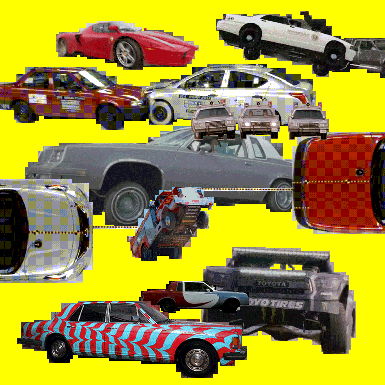
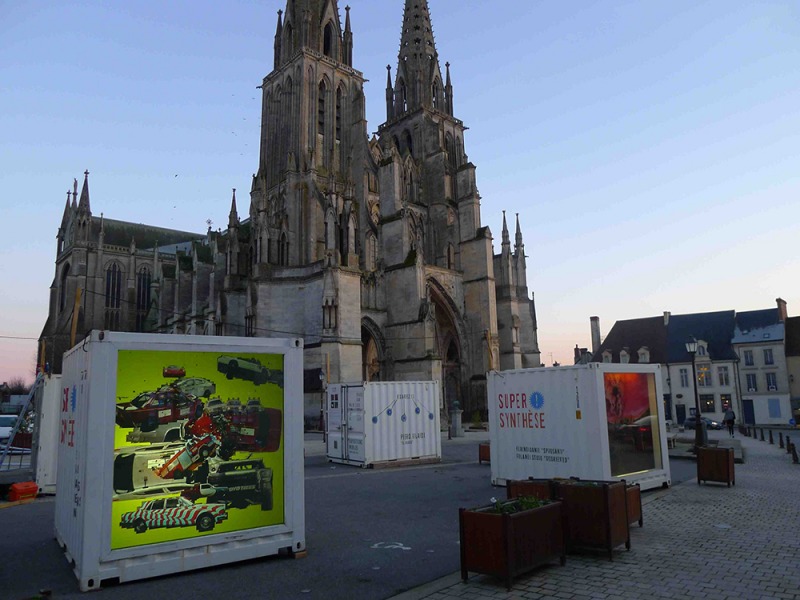 Cerebralconcrete by Lorna Mills, part of Supersynthese curated by Vincent Auvray and touring through Normandy, FR
Cerebralconcrete by Lorna Mills, part of Supersynthese curated by Vincent Auvray and touring through Normandy, FR
BD: For your big Times Square piece, why did you choose to show a mountain?
LM: I didn't choose it. It was curated. I've had doubts about what curators have chosen for large things of mine and in the end I realized, they're right. That was lucky because I didn't initially understand why it worked. After a few viewings, I realized why: that golden yellow came on the screen and suddenly flooded the square. I still haven't gotten past Times Square. I own that square.
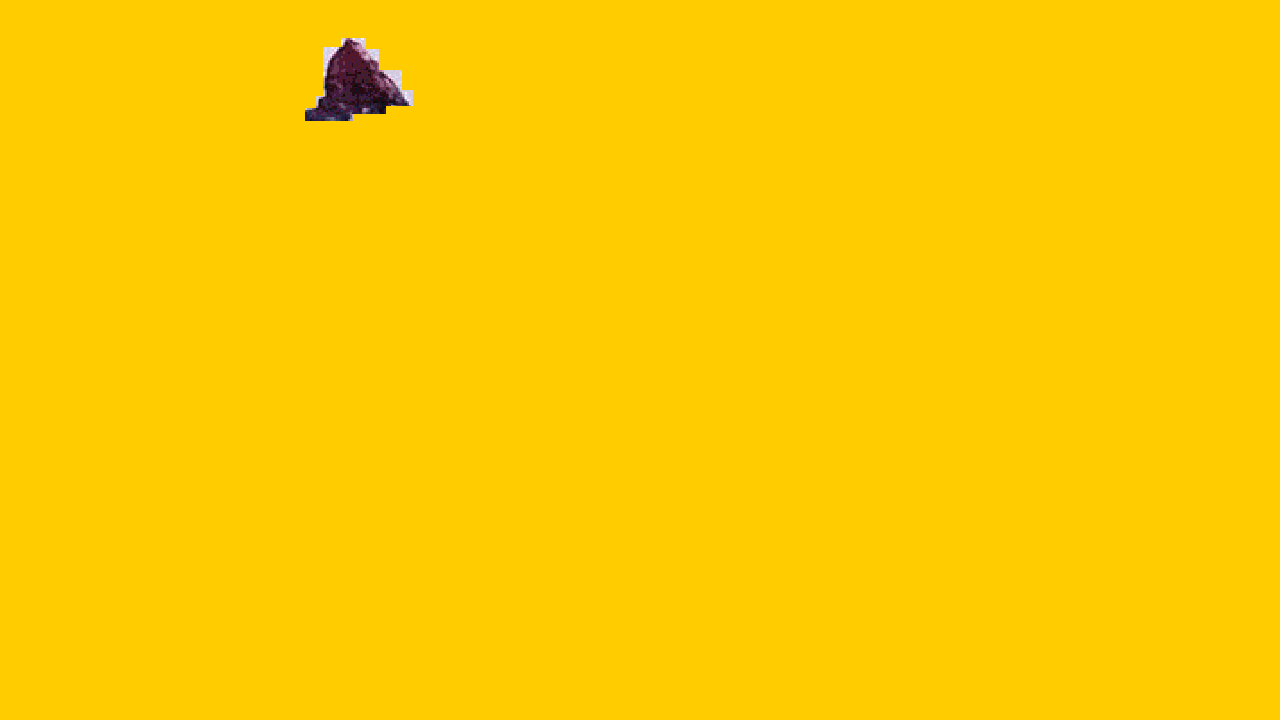
Mountain/Light Time by Lorna Mills
BD: One of your physical works includes a massive collage with book covers. Can you tell me about that?
LM: It’s called The Great Code. I’ve been working on it since 2000 or 2001. I’ve documented every book I’ve ever read. It became the closest thing to a self-portrait I could come up with and the closest thing to a lifetime project, just something that I can always continue to change up the format. It started with grayscale images and I've moved to color now. There are well over 3,000 titles on it. I can install it differently every time I show it, depending on the context. When I showed it in Paris years ago, I bought all the books that were by French authors but in translation closer to the top and the front. It's a way of looking at cultural time and very much a continuation of what I do, because it's highbrow and lowbrow mixed together. It's non-hierarchical. No one book is more important than the other one in terms of the whole. But I admit that the Ayn Rands titles are hidden on the bottom, because we've all read them and we're all embarrassed.
LM: It’s called The Great Code. I’ve been working on it since 2000 or 2001. I’ve documented every book I’ve ever read. It became the closest thing to a self-portrait I could come up with and the closest thing to a lifetime project, just something that I can always continue to change up the format. It started with grayscale images and I've moved to color now. There are well over 3,000 titles on it. I can install it differently every time I show it, depending on the context. When I showed it in Paris years ago, I bought all the books that were by French authors but in translation closer to the top and the front. It's a way of looking at cultural time and very much a continuation of what I do, because it's highbrow and lowbrow mixed together. It's non-hierarchical. No one book is more important than the other one in terms of the whole. But I admit that the Ayn Rands titles are hidden on the bottom, because we've all read them and we're all embarrassed.

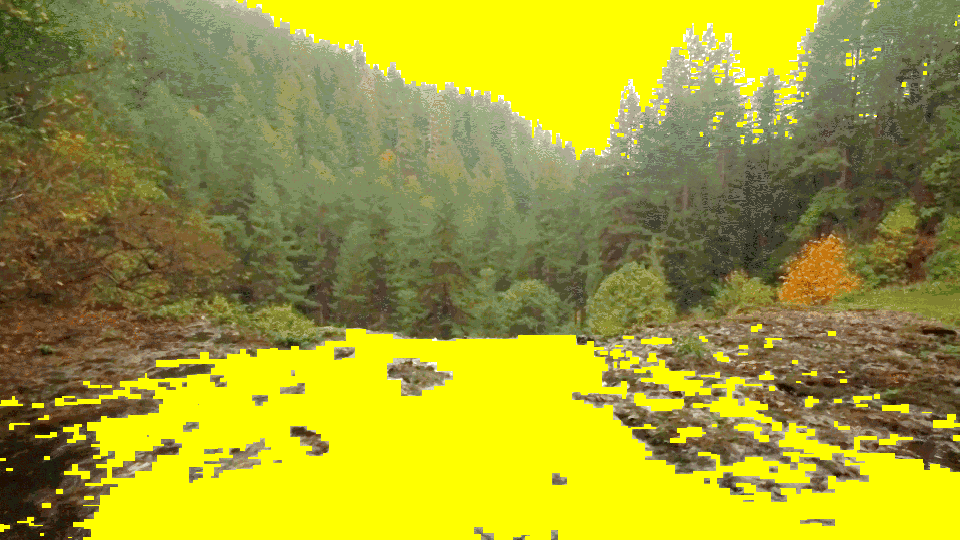
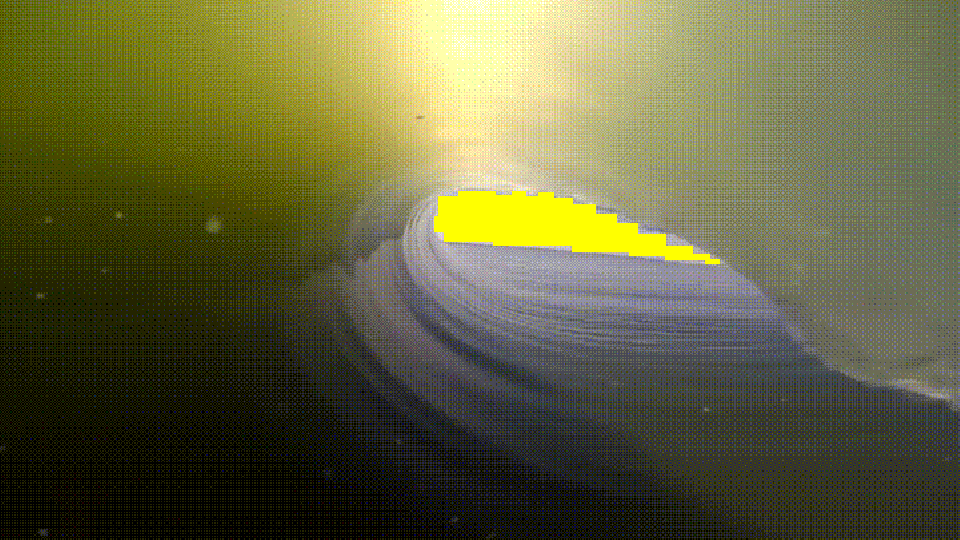
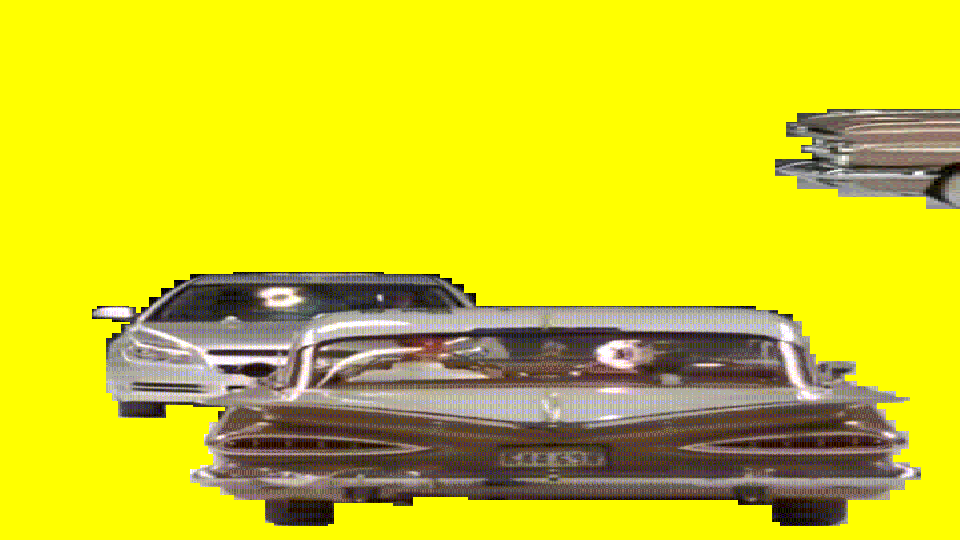
Yellowwhirlaway GIF by Lorna Mills commissioned by The Museum of the Moving Image, NY and GIPHY
Ben Dreith is a writer based in Brooklyn. His fiction is has appeared in X-R-A-Y and Fugitives and Futurists. His critiques on the neo-decadent fiction movement are featured in Maudlin House, while his non-fiction pieces, delving into design and architecture, are prominent at Dezeen, where he serves as the US editor.

